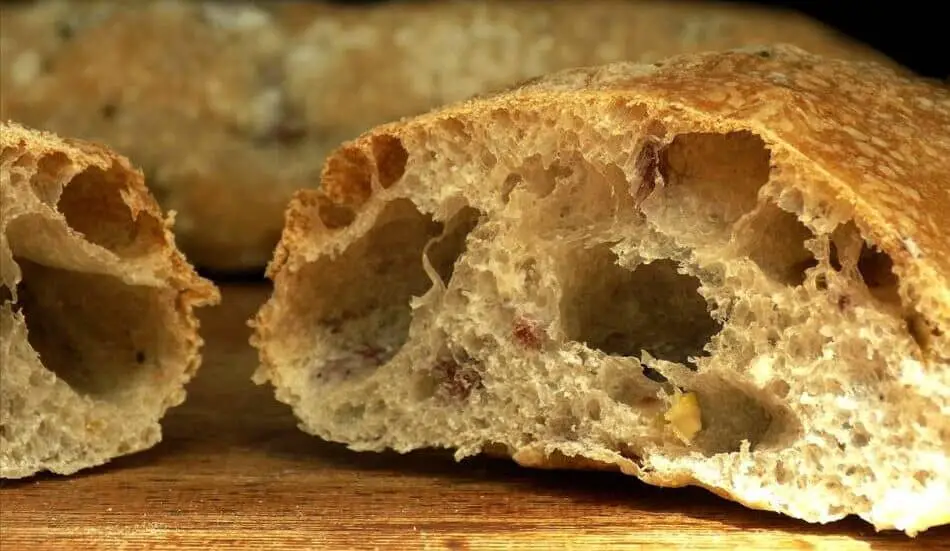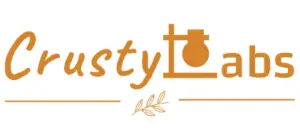Breads rise due to the its leavening agent that releases carbon dioxide gasses into the dough. The gluten network in the dough prevents these carbon dioxide gasses from escaping, causing the internal pressure in the dough to increase, and ultimately rises the dough and bread.
The main difference between a sourdough bread and ciabatta bread is in its leavening agent. Sourdough bread is leavened using wild yeast and bacteria found naturally in the flour of the dough while ciabatta bread is leavened through commercially available yeast such as instant, dry and fresh yeast.
Ciabatta breads also contains higher levels of hydration than sourdough bread. The differences in the leavening agent and hydration level between these two breads leads to differences in how the breads are baked, how they taste and look, and in their nutritional value.

Leavening Agent: Natural Pre-ferment vs Yeasted Pre-ferment
Sourdough bread is leavened using a sourdough starter or natural pre-ferment, which is a mixture of only flour and water that has been left to mature over a long period of time for the natural population of fermenting wild yeast and bacteria to grow in number to be able to leaven bread. Once the sourdough starter is fully matured, it is then introduced into the final dough to leaven it.
Ciabatta bread on the other hand is leavened using a yeasted pre-ferment, which is a mixture of flour, water and commercial yeast that is left to mature before it is introduced into the final dough similar to a sourdough starter. On top of the pre-fermented mixture of flour, water and commercial yeast, additional commercial yeast is also added to the dough to strengthen its leavening ability.
Yeasted pre-ferment is known as a Poolish (in Poland), Biga (in Italy), and Pate Fermentee (in France).
Both sourdough bread and ciabatta breads are made using a pre-ferment where a proportion of flour and water of the final dough composition has been allowed to ferment before the remaining flour and water is added in.
Since sourdough starters/natural pre-ferment do not contain any commercial yeast, the fermentative microbial strains in a sourdough starter is predominantly wild yeast and bacteria. A yeasted pre-ferment however is made of predominantly commercial yeast as these commercial yeasts will out compete the wild yeast and bacteria for food source in the culture.
The difference in the microbial diversity of a sourdough starter and a yeasted pre-ferment brings about differences in the way a sourdough bread and a ciabatta bread is made, and also in the way they taste.
Ingredients: Ciabatta bread has a higher hydration level
| Ingredients | Sourdough Bread | Ciabatta Bread |
| Flour | High protein flour | High protein flour |
| Hydration | 65-75% | More than 75% |
| Salt | Approx. 2% | Approx. 2% |
| Leavening Agent | Sourdough Starter | Yeasted Pre-ferment |
Another difference between a sourdough bread and a ciabatta bread is in its hydration levels. The liquid in both doughs are made up of water; the ciabatta bread has a higher water content than a sourdough bread of the same weight.
Aside from hydration levels and leavening agent, all other ingredients in a sourdough bread is similar to that of a ciabatta bread.
Baking Process: Mixing, fermentation time, shaping and scoring
Mixing
Since ciabatta doughs has a higher hydration level, it is wetter, stickier and weaker than a sourdough. A ciabatta dough requires a longer mixing time, and additional folds to build sufficient dough strength that helps keep the dough from flattening out.
An additional 1 to 2 minutes of mixing time, and 1 – 2 extra folds is required when baking ciabatta breads.
Fermentation time
The yeasted pre-ferment has a much stronger leavening ability than a sourdough starter; ciabatta doughs will finish bulk fermentation and final fermentation in a shorter duration compared to a sourdough bread.
The bulk fermentation and final fermentation time is reduced by about 30 minutes to 1 hour each when baking ciabatta breads.
Shaping and Scoring
The high hydration ciabatta dough is still quite weak even with the additional mixing and folding of the dough. Hence, a ciabatta dough is never shaped and scored as it will most likely collapse under its own weight.
Once a ciabatta dough has finished bulk fermentation, it is divided, dusted well with flour to prevent sticking, and left to final proof on the work bench without any shaping. Once the ciabatta dough has finished proofing, it is immediately loaded into the oven without scoring.
A sourdough on the other hand, is divided and shaped after bulk fermentation. It is then left to proofed in a banneton, and scored before baking.

Flavor and Texture: Sourdough bread vs Ciabatta bread
Flavor
Sourdough bread has a more complex flavor profile and tastes more sour than ciabatta bread due to the presence of lactic acid bacteria in sourdough starters that releases acid as a byproduct of its fermentation reaction.
A yeasted pre-ferment does not have enough lactic acid bacteria to impart a strong sour taste as the commercial yeast strain in the culture is too strong and has out compete the lactic acid bacteria for food source, resulting in a small and weakened population of these acid producing bacterias.
Texture
The sourdough bread rises taller than a ciabatta bread, but has a denser crumb structure due to the lower hydration level. The drier dough of a sourdough bread is stiffer, and resists expansion of the gasses released during fermentaiton, leading to a dense and closed crumb structure.
The ciabatta bread does not rise as tall as a sourdough bread due to the high hydration levels which weakens the dough considerably. However one benefit of having a wet and weakened dough is that it allows the dough to expand freely from the rising fermentation gasses, resulting in a lighter, and more open crumb structure.
Nutritional Value: Sourdough bread vs Ciabatta bread
Although the nutritional value of sourdough bread and ciabatta bread is largely similar, and mostly dependent on the type of flour that you use, the higher quantity of acids in sourdough breads increases the ability of our body to absorb the nutrients in sourdough breads.
Phytic acid is present in bran coating of cereal grains; they interfere with the body’s ability to absorb calcium, zinc, iron, magnesium and copper. Under acidity of sourdough, phytase enzyme is activated which eliminates the effects of phytic acid.
Is there such a thing as a sourdough ciabatta bread?
A sourdough ciabatta bread is essentially replacing the yeasted pre-ferment with a sourdough starter that does not contain any commercial yeast. The sourdough ciabatta will posses the same crumb structure as a regular ciabatta bread, but with an added sourness from the acidity of the sourdough starter.
When replacing the yeasted pre-ferment with a sourdough starter, remember to increase bulk fermentation and final fermentation times by 30 minutes to 1 hour each as a sourdough starter takes a longer time to produce sufficient fermentation gasses for the dough to rise.
Do not shape and score the bread (similar to a regular ciabatta bread) as the high hydration dough will easily collapse under its own weight when over handled.

